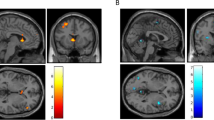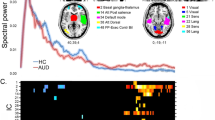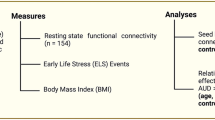Abstract
Considerable research has linked relative reduction in the amplitude of the P3 event-related potential (ERP) during cognitive task performance (i.e., Target-P3) with increased risk of alcohol-related problems. A separate literature indicates that a relative increase in the amplitude of the P3 elicited by cues signaling alcohol availability (i.e., ACR-P3) also is associated with alcohol use and problems. To date, no research has integrated these seemingly discrepant findings. Here, we aimed to demonstrate that P3 amplitudes elicited in different task contexts reflect distinct domains of functioning relevant to problematic alcohol involvement (PAI), and therefore can inform heterogeneity in the etiology of PAI. 156 emerging adults (61% women; 88% White/Non-Hispanic) completed a mental rotation task and a picture-viewing task while ERPs were recorded. Participants also completed questionnaire measures of trait disinhibition, alcohol use, and alcohol-related problems. Findings from regression analyses indicated that (a) Target-P3 was negatively associated and ACR-P3 was positively associated with a PAI latent variable; (b) the two P3s accounted for unique variance in PAI, beyond that accounted for by recent drinking; and (c) the association between Target-P3 and PAI—but not ACR-P3 and PAI—was statistically mediated by trait disinhibition. The present findings highlight the unique contributions of distinct functional domains associated with disinhibition and incentive salience in the etiology of PAI. Moreover, findings are consistent with a nuanced understanding of the P3 ERP, whereby its specific meaning varies according to the task context in which it is elicited.
This is a preview of subscription content, access via your institution
Access options
Subscribe to this journal
Receive 13 print issues and online access
$259.00 per year
only $19.92 per issue
Buy this article
- Purchase on Springer Link
- Instant access to full article PDF
Prices may be subject to local taxes which are calculated during checkout




Similar content being viewed by others
Notes
The YAACQ was added part-way into the study, and thus scores for this measure were available for 103 rather than all participants.
A Heywood case emerged in this model, involving the loading of the YAACQ total score onto the latent alcohol problems factor; thus, the model was re-run fixing this loading to 1.0. Model fit statistics and further modeling analyses utilized this revised model.
In response to a helpful anonymous reviewer comment concerning divergent validity, we also tested indirect pathways through alcohol expectancies as assessed by the Comprehensive Effects of Alcohol Questionnaire (Fromme, Stroot, & Kaplan, 1993). None of this measure’s 7 subscales (Sociability, Tension Reduction, Liquid Courage, Sexuality, Cognitive and Behavioral Impairment, Risk and Aggression, Self-Perception) emerged as a significant mediator when used in place of ESI-Disinhibition in the current model (all indirect effect p’s > 0.12). For completeness, expectancy, and valuation scores were calculated separately for each of the subscales and tested as mediators; again, no significant indirect effects emerged in any of the 14 models for these scores (all indirect effect p’s > 0.11).
Magnitude of loadings and prediction of the ACR-P3 from the general factor did not differ appreciably when including mean P3 response to pleasant pictures [47] as a fourth indicator of the general P3 factor. The λs for Target-P3, NNB-P3, NAB-P3, and Pleasant-P3 in this alternative model were 0.51, 0.59, 0.86, and 0.74, respectively, and the β for prediction of ACR-P3 from the four-indicator general P3 factor was 0.72, p < 0.001.
References
Nutt DJ, King LA, Phillips LD. Drug harms in the UK: a multicriteria decision analysis. Lancet. 2010;376:1558–65.
Littlefield AK, Sher KJ, Wood PK. Is “maturing out” of problematic alcohol involvement related to personality change? J Abnorm Psychol. 2009;118:360–74.
Schulenberg JE, Maggs JL. A developmental perspective on alcohol use and heavy drinking during adolescence and the transition to young adulthood. J Stud Alcohol Suppl. 2002;2002:54–70.
American Psychiatric Association. Diagnostic and statistical manual of mental disorders. 5th ed. Arlington: VA; 2013.
Boness CL, Lane SP, Sher KJ. Not all alcohol use disorder criteria are equally severe: Toward severity grading of individual criteria in college drinkers. Psychol Addictive Behav. 2019;33:35–49.
Boness CL, Watts AL, Moeller KN, Sher KJ. The etiologic, theory-based, ontogenetic hierarchical framework of alcohol use disorder: a translational systematic review of reviews. Psychol Bull. 2021;147:1075–123.
Kwako LE, Momenan R, Litten RZ, Koob GF, Goldman D. Addictions neuroclinical assessment: a neuroscience-based framework for addictive disorders. Biol Psychiatry. 2016;80:179–89.
Lane SP, Sher KJ. Limits of current approaches to diagnosis severity based on criterion counts: an example with DSM-5 alcohol use disorder. Clin Psychol Sci. 2015;3:819–35.
Litten RZ, Ryan ML, Falk DE, Reilly M, Fertig JB, Koob GF. Heterogeneity of alcohol use disorder: understanding mechanisms to advance personalized treatment. Alcohol Clin Exp Res. 2015;39:579–84.
Sher KJ. Moving the alcohol addiction RdoC forward. Alcohol Clin Exp Res. 2015;39:591.
Begleiter H, Porjesz B, Bihari B, Kissin B. Event-related potentials in boys at risk for alcoholism. Science. 1984;225:1493–6.
Costa L, Bauer L, Kuperman S, Porjesz B, O’Connor S, Hesselbrock V, et al. Frontal P300 decrements, alcohol dependence, and antisocial personality disorder. Biol Psychiatry. 2000;47:1064–71.
Hesselbrock V, Bauer L, O’Connor S, Gillen R. Reduced P300 amplitude in relation to family history of alcoholism and antisocial personality disorder among young men at risk for alcoholism. Alcohol Alcohol Suppl. 1993;2:95–100.
Porjesz B, Begleiter H, Reich T, Van Eerdewegh P, Edenberg HJ, Foroud T, et al. Amplitude of visual P3 event-related potential as a phenotypic marker for a predisposition to alcoholism: preliminary results from the COGA Project Collaborative Study on the Genetics of Alcoholism. Alcohol Clin Exp Res. 1998;22:1317–23.
Bauer LO, O’Connor S, Hesselbrock VM. Frontal P300 decrements in antisocial personality disorder. Alcohol Clin Exp Res. 1994;18:1300–5.
Iacono WG, Carlson SR, Taylor J, Elkins IJ, McGue M. Behavioral disinhibition and the development of substance-use disorders: findings from the Minnesota Twin Family Study. Dev Psychopathol. 1999;11:869–900.
Krueger RF, Hicks BM, Patrick CJ, Carlson SR, Iacono WG, McGue M. Etiologic connections among substance dependence, antisocial behavior and personality: modeling the externalizing spectrum. J Abnorm Psychol. 2002;111:411–24.
Bauer LO, Hesselbrock VM. P300 decrements in teenagers with conduct problems: implications for substance abuse risk and brain development. Biol Psychiatry. 1999;46:263–72.
Iacono WG, Carlson SR, Malone SM, McGue M. P3 event-related potential amplitude and the risk for disinhibitory disorders in adolescent boys. Arch Gen Psychiatry. 2002;59:750–7.
Hicks BM, Bernat E, Malone SM, Iacono WG, Patrick CJ, Krueger RF, et al. Genes mediate the association between P3 amplitude and externalizing disorders. Psychophysiology. 2007;44:98–105.
Joyner KJ, Yancey JR, Venables NC, Burwell SJ, Iacono WG, Patrick CJ. Using a co-twin control design to evaluate alternative trait measures as indices of liability for substance use disorders. Int J Psychophysiol. 2020;148:75–83.
Yancey JR, Venables NC, Hicks BM, Patrick CJ. Evidence for a heritable brain basis to deviance-promoting deficits in self-control. J Crim Justice. 2013;41:309–17.
Littel M, Euser AS, Munafò MR, Franken IH. Electrophysiological indices of biased cognitive processing of substance-related cues: a meta-analysis. Neurosci Biobehav Rev. 2012;36:1803–16.
Namkoong K, Lee E, Lee CH, Lee BO, An SK. Increased P3 amplitudes induced by alcohol‐related pictures in patients with alcohol dependence. Alcohol Clin Exp Res. 2004;28:1317–23.
Bartholow BD, Henry EA, Lust SA. Effects of alcohol sensitivity on P3 event-related potential reactivity to alcohol cues. Psychol Addictive Behav. 2007;21:555–63.
Bartholow BD, Lust SA, Tragesser SL. Specificity of P3 event-related potential reactivity to alcohol cues in individuals low in alcohol sensitivity. Psychol Addictive Behav. 2010;24:220–8.
Cofresí RU, Kohen CB, Motschman CA, Wiers RW, Piasecki TM, Bartholow BD. Behavioral response bias and event-related brain potentials implicate elevated incentive salience attribution to alcohol cues in emerging adults with lower sensitivity to alcohol. Addiction. 2022;117:892–904.
Cofresí RU, Piasecki TM, Bartholow BD. Acute sensitization of the P3 event-related potential response (ERP) to beverage images and the risk for alcohol use disorder (AUD). Addictn Neurosci. 2022;4:100041.
Fleming KA, Cofresí RU, Bartholow BD. Transfer of incentive salience from a first-order alcohol cue to a novel second-order alcohol cue among individuals at risk for alcohol use disorder: electrophysiological evidence. Addiction. 2021;116:1734–46.
Martins JS, Bartholow BD, Cooper ML, Irvin KM, Piasecki TM. Interactive effects of naturalistic drinking context and alcohol sensitivity on neural alcohol cue-reactivity responses. Alcohol Clin Exp Res. 2019;43:1777–89.
Flagel SB, Robinson TE. Neurobiological basis of individual variation in stimulus-reward learning. Curr Opin Behav Sci. 2017;13:178–85.
Cofresí RU, Bartholow BD, Piasecki TM. Evidence for incentive salience sensitization as a pathway to alcohol use disorder. Neurosci Biobehav Rev. 2019;107:897–926.
Jurado-Barba R, Sion A, Martínez-Maldonado A, Domínguez-Centeno I, Prieto-Montalvo J, Navarrete F, et al. Neuropsychophysiological measures of alcohol dependence: can we use EEG in the clinical assessment? Front Psychiatry. 2020;11:676.
Robinson TE, Berridge KC. The neural basis of drug craving: an incentive–sensitization theory of addiction. Brain Res Rev. 1993;18:247–91.
Robinson TE, Berridge KC. The psychology and neurobiology of addiction: an incentive-sensitization view. Addiction. 2000;95:91–117.
Cui C, Noronha A, Morikawa H, Alvarez VA, Stuber GD, Szumlinski KK, et al. New insights on neurobiological mechanisms underlying alcohol addiction. Neuropharmacology. 2013;67:223–32.
DePoy L, Daut R, Brigman JL, MacPherson K, Crowley N, Gunduz-Cinar O, et al. Chronic alcohol produces neuroadaptations to prime dorsal striatal learning. Proc Natl Acad Sci. 2013;110:14783–8.
Weiss F, Ciccocioppo R, Parsons LH, Katner S, Liu XIU, Zorrilla EP, et al. Compulsive drug‐seeking behavior and relapse: neuroadaptation, stress, and conditioning factors. Ann N Y Acad Sci. 2001;937:1–26.
Nguyen-Louie TT, Courtney KE, Squeglia LM, Bagot K, Eberson S, Migliorini R, et al. Prospective changes in neural alcohol cue reactivity in at-risk adolescents. Brain Imaging Behav. 2018;12:931–41.
Nelson LD, Patrick CJ, Bernat EM. Operationalizing proneness to externalizing psychopathology as a multivariate psychophysiological phenotype. Psychophysiology. 2011;48:64–72.
Patrick CJ, Venables NC, Yancey JR, Hicks BM, Nelson LD, Kramer MD. A construct-network approach to bridging diagnostic and physiological domains: application to assessment of externalizing psychopathology. J Abnorm Psychol. 2013;122:902–16.
Venables NC, Foell J, Yancey JR, Kane MJ, Engle RW, Patrick CJ. Quantifying inhibitory control as externalizing proneness: a cross-domain model. Clin Psychol Sci. 2018;6:561–80.
Young SE, Friedman NP, Miyake A, Willcutt EG, Corley RP, Haberstick BC, et al. Behavioral disinhibition: liability for externalizing spectrum disorders and its genetic and environmental relation to response inhibition across adolescence. J Abnorm Psychol. 2009;118:117–30.
Dunning JP, Parvaz MA, Hajcak G, Maloney T, Alia-Klein N, Woicik PA, et al. Motivated attention to cocaine and emotional cues in abstinent and current cocaine users— an ERP study. Eur J Neurosci. 2011;33:1716–23.
Parvaz MA, Moeller SJ, Malaker P, Sinha R, Alia-Klein N, Goldstein RZ. Abstinence reverses EEG-indexed attention bias between drug-related and pleasant stimuli in cocaine-addicted individuals. J Psychiatry Neurosci. 2017;42:78–86.
Versace F, Lam CY, Engelmann JM, Robinson JD, Minnix JA, Brown VL, et al. Beyond cue reactivity: blunted brain responses to pleasant stimuli predict long‐term smoking abstinence. Addictn Biol. 2012;17:991–1000.
Versace F, Engelmann JM, Deweese MM, Robinson JD, Green CE, Lam CY, et al. Beyond cue reactivity: non-drug-related motivationally relevant stimuli are necessary to understand reactivity to drug-related cues. Nicotine Tob Res. 2017;19:663–9.
Martins JS, Joyner KJ, Morris D, Patrick CJ, Bartholow BD. Differential brain responses to alcohol-related and natural rewards are associated with alcohol use and problems: evidence for reward dysregulation. Addictn Biol. 2022;27:e13118.
Hajcak G, Foti D. Significance?… significance! empirical, methodological, and theoretical connections between the late positive potential and P300 as neural responses to stimulus significance: an integrative review. Psychophysiology. 2020;57:e13570.
Nieuwenhuis S, Aston-Jones G, Cohen JD. Decision making, the P3, and the locus coeruleus-norepinephrine system. Psychol Bull. 2005;131:510–32.
Campanella S, Schroder E, Kajosch H, Hanak C, Veeser J, Amiot M, et al. Neurophysiological markers of cue reactivity and inhibition subtend a three-month period of complete alcohol abstinence. Clin Neurophysiol. 2020;131:555–65.
Read JP, Kahler CW, Strong DR, Colder CR. Development and preliminary validation of the Young Adult Alcohol Consequences Questionnaire. J Stud Alcohol. 2006;67:169–78.
Read JP, Merrill JE, Kahler CW, Strong DR. Predicting functional outcomes among college drinkers: reliability and predictive validity of the Young Adult Alcohol Consequences Questionnaire. Addictive Behav. 2007;32:2597–610.
NIAAA. Task Force on Recommended Alcohol Questions. Bethesda: MD; 2003.
Krueger RF, Markon KE, Patrick CJ, Benning SD, Kramer M. Linking antisocial behavior, substance use, and personality: an integrative quantitative model of the adult externalizing spectrum. J Abnorm Psychol. 2007;116:645–66.
Joyner KJ, Bowyer CB, Yancey JR, Venables NC, Foell J, Worthy DA, et al. Blunted reward sensitivity and trait disinhibition interact to predict substance use problems. Clin Psychol Sci. 2019;7:1109–24.
Stritzke WG, Breiner MJ, Curtin JJ, Lang AR. Assessment of substance cue reactivity: advances in reliability, specificity, and validity. Psychol Addictive Behav. 2004;18:148–59.
Lang P, Bradley MM. The International Affective Picture System (IAPS) in the study of emotion and attention. Handb Emot Elicitation Assess. 2007;29:70–73.
Patrick CJ, Foell J, Venables NC, Worthy DA. Substance use disorders as externalizing outcomes. In: TP Beauchaine, SP Hinshaw, editors. Oxford handbook of externalizing spectrum disorders. New York: Oxford University Press; 2016. p. 38–60.
Paulhus DL, Robins RW, Trzesniewski KH, Tracy JL. Two replicable suppressor situations in personality research. Multivar Behav Res. 2004;39:303–28.
Polich J. Neuropsychology of P300. In: SJ Luck, ES Kappenman, editors. Oxford Handbook of Event-related Potential Components. New York: Oxford University Press; 2012. p. 159–88.
Polich J. Task difficulty, probability, and inter-stimulus interval as determinants of P300 from auditory stimuli. Electroencephalogr Clin Neurophysiol. 1987;68:311–20.
Polich J. Updating P300: an integrative theory of P3a and P3b. Clin Neurophysiol. 2007;118:2128–48.
Dien J, Spencer KM, Donchin E. Parsing the late positive complex: mental chronometry and the ERP components that inhabit the neighborhood of the P300. Psychophysiology. 2004;41:665–78.
Donchin E, Coles MG. Is the P300 component a manifestation of context updating? Behav Brain Sci. 1988;11:357–74.
Gratton G, Bosco CM, Kramer AF, Coles MG, Wickens CD, Donchin E. Event-related brain potentials as indices of information extraction and response priming. Electroencephalogr Clin Neurophysiol. 1990;75:419–32.
Mecklinger A, Ullsperger P. P3 varies with stimulus categorization rather than probability. Electroencephalogr Clin Neurophysiol. 1993;86:395–407.
Twomey DM, Murphy PR, Kelly SP, O’Connell RG. The classic P300 encodes a build‐to‐threshold decision variable. Eur J Neurosci. 2015;42:1636–43.
Hilgard J, Weinberg A, Hajcak Proudfit G, Bartholow BD. The negativity bias in affective picture processing depends on top-down and bottom-up motivational significance. Emotion. 2014;14:940–9.
Weinberg A, Hilgard J, Bartholow BD, Hajcak G. Emotional targets: evaluative categorization as a function of context and content. Int J Psychophysiol. 2012;84:149–54.
Bradley MM. Natural selective attention: orienting and emotion. Psychophysiology. 2009;46:1–11.
Uddin LQ, Nomi JS, Hébert-Seropian B, Ghaziri J, Boucher O. Structure and function of the human insula. J Clin Neurophysiol. 2017;34:300–6.
Ventura R, Latagliata EC, Morrone C, La Mela I, Puglisi-Allegra S. Prefrontal norepinephrine determines attribution of “high” motivational salience. PloS ONE. 2008;3:e3044.
Goulden N, Khusnulina A, Davis NJ, Bracewell RM, Bokde AL, McNulty JP, et al. The salience network is responsible for switching between the default mode network and the central executive network: replication from DCM. Neuroimage. 2014;99:180–90.
Menon V, Uddin LQ. Saliency, switching, attention and control: a network model of insula function. Brain Struct Funct. 2010;214:655–67.
Sridharan D, Levitin DJ, Menon V. A critical role for the right fronto-insular cortex in switching between central-executive and default-mode networks. Proc Natl Acad Sci. 2008;105:12569–74.
Patrick CJ, Bernat EM. From markers to mechanisms: using psychophysiological measures to elucidate basic processes underlying aggressive externalizing behavior. In: S Hodgins, E Viding, A Plodowski, editors. Persistent violent offenders: neuroscience and rehabilitation. London: Oxford University Press: 2009. p. 223–50.
Baskin-Sommers AR, Krusemark EA, Curtin JJ, Lee C, Vujnovich A, Newman JP. The impact of cognitive control, incentives, and working memory load on the P3 responses of externalizing prisoners. Biol Psychol. 2014;96:86–93.
Robinson TE, Yager LM, Cogan ES, Saunders BT. On the motivational properties of reward cues: individual differences. Neuropharmacology. 2014;76:450–9.
Piasecki TM, Fleming KA, Trela CJ, Bartholow BD. P3 event-related potential reactivity to smoking cues: relations with craving, tobacco dependence, and alcohol sensitivity in young adult smokers. Psychol Addictive Behav. 2017;31:61–72.
Perkins ER, Joyner KJ, Patrick CJ, Bartholow BD, Latzman RD, DeYoung CG, et al. Neurobiology and the hierarchical taxonomy of psychopathology: progress toward ontogenetically informed and clinically useful nosology. Dialogues Clin Neurosci. 2020;22:51–63.
Cicchetti D, Rogosch FA. Equifinality and multifinality in developmental psychopathology. Dev Psychopathol. 1996;8:597–600.
Lillie FR. The gene and the ontogenetic process. Science. 1927;66:361–8.
Patrick CJ, Hajcak G. RdoC: translating promise into progress. Psychophysiology. 2016;53:415–24.
Senner NR, Conklin JR, Piersma T. An ontogenetic perspective on individual differences. Proc R Soc B Biol Sci. 2015;282:20151050.
Patrick CJ, Iacono WG, Venables NC. Incorporating neurophysiological measures into clinical assessments: fundamental challenges and a strategy for addressing them. Psychol Assess. 2019;31:1512–29.
Funding
Data collection was supported by grants R01 AA025451 (PI: Bartholow) and T32 AA013526 (PI: McCarthy) from the National Institute on Alcohol Abuse and Alcoholism (NIAAA) and R01 AA019546 from NIAAA/the Office of Social Sciences and Behavioral Research (PI: McCarthy). Preparation of this article was supported by NIAAA grants R01 AA030728 (PI: Bartholow) and R01 AA030914 (PI: Bartholow), grant R36 DA050049 from the National Institute on Drug Abuse (PI: Joyner), and grant W911NF-14-1-0018 from the US Army (PI: Patrick). The content of this article is solely the responsibility of the authors and does not necessarily represent the official views of the U.S. Government, Department of Defense, Department of the Army, Department of Veterans Affairs, or U.S. Recruiting Command.
Author information
Authors and Affiliations
Contributions
KJJ leads conceptualization, analysis, and results interpretation, and co-leads initial drafting and edits. CJP co-leads initial drafting and edits. DHM led data collection and management and contributed edits. DMM contributed edits. BDB co-led conceptualization, initial drafting, and edits, supervised data collection and management, and secured funding for primary data collection.
Corresponding author
Ethics declarations
Competing interests
The authors declare no competing interests.
Additional information
Publisher’s note Springer Nature remains neutral with regard to jurisdictional claims in published maps and institutional affiliations.
Supplementary information
Rights and permissions
Springer Nature or its licensor (e.g. a society or other partner) holds exclusive rights to this article under a publishing agreement with the author(s) or other rightsholder(s); author self-archiving of the accepted manuscript version of this article is solely governed by the terms of such publishing agreement and applicable law.
About this article
Cite this article
Joyner, K.J., Patrick, C.J., Morris, D.H. et al. Variants of the P3 event-related potential operate as indicators of distinct mechanisms contributing to problematic alcohol use. Neuropsychopharmacol. (2024). https://doi.org/10.1038/s41386-024-01874-7
Received:
Revised:
Accepted:
Published:
DOI: https://doi.org/10.1038/s41386-024-01874-7



